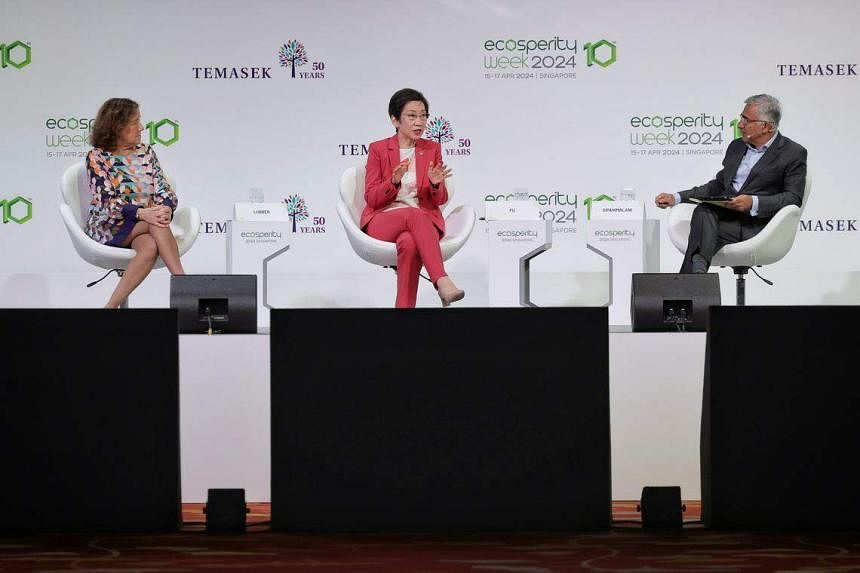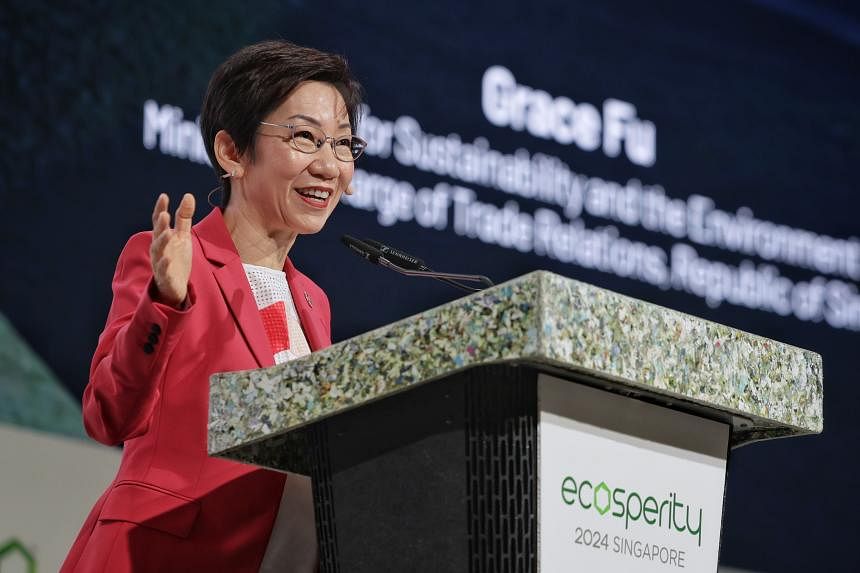SINGAPORE – The South-east Asian region needs over a trillion dollars to meet its 2030 climate change targets, but unlocking the funding needed to cut emissions would require governments to develop conducive regulatory and policy environments to give investors the confidence to take the plunge.
This was a key theme that emerged from the first day of Ecosperity Week, a sustainability conference convened by Singapore’s investment company, Temasek, and held from April 15 to 17 at Marina Bay Sands.
Speaking at a panel discussion on April 15, Minister for Sustainability and the Environment Grace Fu highlighted a few key areas where policy environments could help or hinder climate action.
To promote climate action, for example, governments can provide or facilitate infrastructural support – such as energy grids that can increase renewable energy deployment – and implement policies that spur innovation, she said.
Pointing to Singapore’s carbon tax scheme, Ms Fu said the country ploughs the carbon tax revenue “back into the system” to encourage research and development, and to push industries to adopt newer clean technologies, such as hydrogen and carbon capture projects.
As Singapore looks to import some 30 per cent of its energy from renewable sources in the region by 2035, infrastructural investments will also be needed to upgrade the electricity grid and build power lines, she added.
To fund this, the Government has set aside a future energy fund with an initial injection of $5 billion in order to support the infrastructural needs of this green energy transition, Ms Fu said.
On the other hand, there are policies that could also hinder climate action. Citing the example of fossil fuel subsidies that can distort market signals, she such subsidies can make it difficult to ramp up renewable energy, even if the cost of renewable technology is comparable to the price of fossil fuels.
About 60 per cent of the power generated in the Asia-Pacific comes from burning coal, which produces planet-warming emissions driving climate change.
The International Energy Agency’s (IEA) 2022 South-east Asia Energy Outlook report projected that energy demand in South-east Asia has increased, on the average, by around 3 per cent a year over the past two decades, and will continue till 2030.
At a separate panel discussion on reducing fossil fuel use, panellists said a big challenge to South-east Asia’s decarbonisation efforts is that many coal plants in the region are relatively young.
Many coal plants in the region have an average remaining lifespan of between 12 and 15 years, and observers have highlighted that this timeline is incompatible with the global push to bring planet-warming emissions down to net-zero by 2050.
IEA’s chief energy economist Tim Gould said at the event that there is a large amount of “unrecovered capital” in these young plants of over $1 trillion.
“When you have those plants, often with quite restrictive (power purchase agreements) underpinning their operation, it doesn’t allow for much room for renewables to grow, even if the economics are very compelling, so I think there is a need for creative thinking here,” he said.
“There is a need for creative financing approaches in order to get that balance right, and to maintain electricity security affordability while offering the potential to bring lower-cost cheap and clean energy into the system.”
Singapore is contributing to discussions on this front.
For example, to accelerate the early retirement of coal plants in the region, Singapore’s central bank is trialling the use of carbon credits to close the financing gap of decommissioning coal plants ahead of their expected lifespan.
At the United Nations climate change conference COP28 in 2023, the Monetary Authority of Singapore launched the Transition Credits Coalition, or Traction, which will help identify barriers and potential solutions to develop transition credits as viable market solutions, said Ms Fu.
Funds raised through such “transition credits” will be used to replace a coal plant with a renewable energy source.
In such a scheme, one carbon credit represents one tonne of carbon dioxide that is prevented from being released from the early closure of the coal plant. The aim is to generate revenue that can be used to compensate the owner of the coal plant for its early closure.
Singapore is also contributing to decarbonisation efforts on other fronts, Ms Fu added in her keynote speech.
For example, all listed companies here must make climate-related disclosures from their 2025 financial year, followed by large non-listed companies from financial year 2027. These disclosures, which include measuring the size of a firm’s carbon footprint, have to be aligned with the standards set by the International Sustainability Standards Board, she said.
Separately, a new Emissions Factor Registry was launched at Ecosperity Week on April 15.

The registry aims to help businesses here measure their carbon emissions more accurately so that they can make more informed sustainability decisions.
The registry is a database of emissions factors, which act as conversion factors that translate metrics of various business activities, such as water, energy, transportation and waste generation, into their corresponding amount of greenhouse gas emissions.
The initiative led by the Singapore Business Federation (SBF) gives a Singapore context to such calculations. Currently, many businesses calculate their emissions using data from international sources, like the United States and Britain.
But Singapore’s emissions factor for energy use is significantly different from places where the electricity grid is fed by coal-generated power. In Singapore, most electricity is generated from burning natural gas – a fossil fuel which is cleaner than coal.
The SBF said that more emissions factors for new categories and activities will be developed and released based on industry consultations and demand.
Ms Fu added: “This (registry) will help our businesses track and report their emissions more easily and accurately, saving time and effort. In turn, it will empower them to make informed sustainability decisions based on data and (their) environmental impact.”


